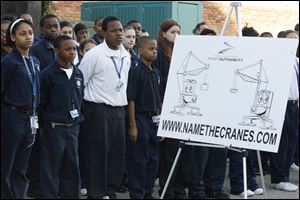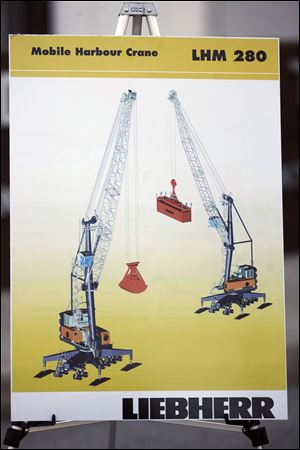
Contest announced to 'name the cranes'
4/1/2010
The new cranes, which are funded by the American Recovery and Reinvestment Act, are twice as productive as those now in use at the port, with the ability to move up to 35 cargo containers per hour. While the old cranes have been fine for handling traditional bulk cargo since the 1950s, they are aging and will be enhanced by the addition of the new equipment. Mobile cranes like the new Liebherr models on order are rare at ports on the Great Lakes.
Jetta Fraser

Fifth graders from the Maritime Academy downtown listen as representatives of the Toledo-Lucas County Port Authority announce a contest, open to area youth, to name two new cranes that will be arriving in May for use at the Port of Toledo. From left in front are Myah Stewart, Lance Chaney, David Smith, and Anthony Reese, standing next to a poster done by The Blade's editorial cartoonist, Kirk Walters. The Name the Cranes contest begins today and continues through April 30. Area students can submit their suggestions to the Web site namethecranes.com.

The new cranes, which are funded by the American Recovery and Reinvestment Act, are twice as productive as those now in use at the port, with the ability to move up to 35 cargo containers per hour. While the old cranes have been fine for handling traditional bulk cargo since the 1950s, they are aging and will be enhanced by the addition of the new equipment. Mobile cranes like the new Liebherr models on order are rare at ports on the Great Lakes.